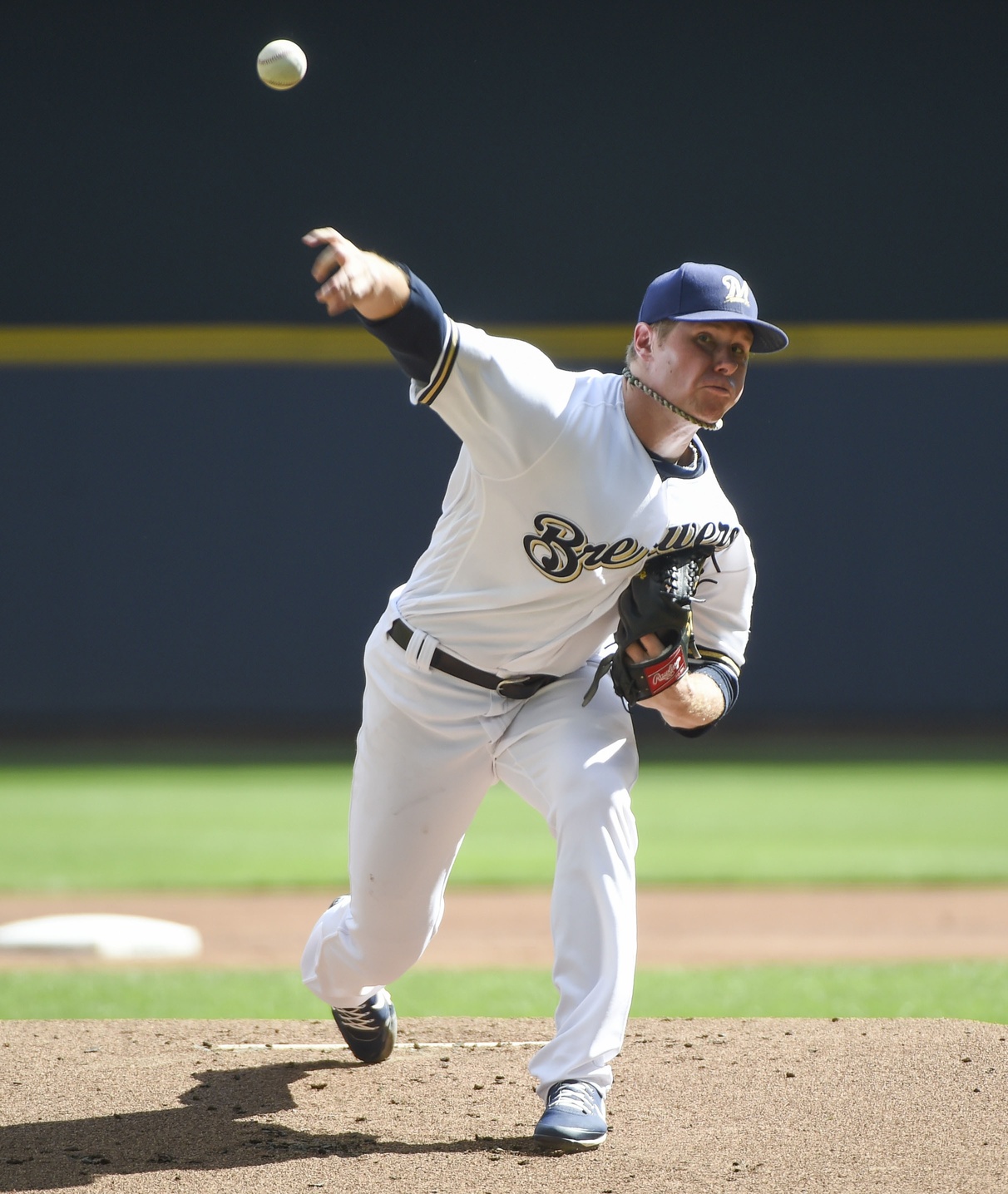Yesterday, the Brewers signed two contracts that will keep key players from 2017 with the organization.
- GM David Stearns signed RHP Chase Anderson to a guaranteed two-year contract, which also includes escalators and club options that could extent to a four-year deal north of $30 million. This deal gambles on the distance between the gains Anderson exhibited in 2017 (where Anderson was a top 10 National League pitcher in terms of runs prevented) and his career trajectory of serviceable middle-to-back rotation depth. What Anderson’s emergence should solidify is the righty’s “true” 50 Overall Future Potential (OFP) role, as a strong middle rotation depth option with some potential upside given MLB adjustments.
| 2017 NL Runs Prevented | IP | RnPrv |
|---|---|---|
| Max Scherzer | 200.7 | 43 |
| Clayton Kershaw | 175 | 37 |
| Stephen Strasburg | 175.3 | 37 |
| Gio Gonzalez | 201.0 | 36 |
| Robbie Ray | 162.0 | 35 |
| Zack Greinke | 202.3 | 34 |
| Zack Godley | 155.0 | 27 |
| Chase Anderson | 141.3 | 26 |
| Alex Wood | 152.3 | 25 |
| Kyle Hendricks | 139.7 | 23 |
- The second contract involves fan-favorite Eric Sogard, a utility depth option that provided a key hot streak in the middle of the season. Prior to a July injury, Sogard batted .331 Average / .438 On-Base Percentage / .485 Slugging Percentage in 162 plate appearances, with a 20 strikeout / 22 walk plate discipline profile giving the Brewers a solid contact-patience option for the batting order. Sogard’s deal is for one-year, $2.4 million (with incentives that could reach $3 million), which gives the Brewers a low-risk renewal for quality infield depth.
In terms of assessing both contracts for Anderson and Sogard against their 2018 roster surplus, it is important to focus on Stearns’s use of both contracts to solidify certain roles for the roster. Here, there is somewhat of a disconnect between Anderson’s WARP (0.4 career, with three replacement seasons prior to 2017) and Deserved Runs Average profile (4.05 in 2017, 5.15 career), and his established career role as steady middle rotation pitcher. This is arguably one place where WARP does not necessarily capture a pitcher’s value (140-150 innings pitched of serviceable depth), and it is clear that Stearns is using this contract to secure that role rather than reward Anderson for previous performance (as performance from 2014-2016 would certainly offset 2017 in this regard). Sogard’s contract is much easier to assess, as keeping the depth option infielder for one year at a maximum of $3 million basically “zeroes out” his surplus; it will simply be worthwhile to have a quality contact-patience profile like Sogard either filling in plate appearances around the infield, or even starting at second base for short periods of time.
| Extensions ($ are $M) | 2017 WARP | 2018 Surplus | OFP Role | Depreciated Contract Value | OFP Contract Value |
|---|---|---|---|---|---|
| Chase Anderson | 2.4 | $5.0 | $19.5 | -$5.1 | $7.2 |
| Eric Sogard | 1.2 | $11.0 | $1.4 | $5.0 | $0.0 |
Neither of these deals should be viewed as valuable in the sense of providing Milwaukee cost savings for production, or even for securing long-term better than average production for the team. Where these deals indicate success for Milwaukee’s front office is to extend the identity of the 2017 club, a team that contended precisely because of their deep collection of serviceable players. Both Anderson and Sogard were crucial elements of that identity, and Stearns gambling on both roles continuing for the club.
Digging deeper on Anderson, it should be added that expectations of the righty’s decline have been on the books since his career began, and his predicted decline by advanced metrics such as DRA and Contextual Fielding Independent Pitching (cFIP) has never truly materialized (save for 2015-2016, perhaps).
| Anderson | Innings Pitched | Runs Prevented | DRA RunPrv | cFIP RunPrv | Regression |
|---|---|---|---|---|---|
| 2014 | 114.3 | -4 | -15 | -5 | -3 |
| 2015 | 152.7 | 0 | -13 | -7 | -9 |
| 2016 | 151.7 | -6 | -24 | -15 | -12 |
| 2017 | 141.3 | 26 | 9 | 4 | -21 |
What is intriguing here is that should Anderson “decline” to his expected level of production in 2017, a 4.05 DRA evidences solidly better than average production, and his cFIP suggests the same. Fan or analytical narratives about regression for the righty must consider his ability to consistently “pitch beyond his peripherals” throughout his career, as well as his ability to improve (demonstrated modestly in 2015, and more severely in 2017). Once again, no one should expect Anderson to continue preventing runs at the top of the National League; instead, his ability to adjust his repertoire and strike zone approach should be the keys to discerning the next step in his career arc.
Photo Credit: Benny Sieu, USAToday Sports Images
